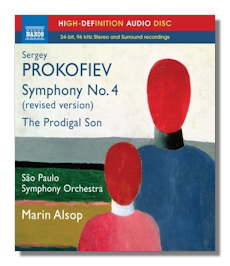
The Internet's Premier Classical Music Source
Related Links
- Prokofieff Reviews
- Latest Reviews
- More Reviews
-
By Composer
-
Collections
DVD & Blu-ray
Books
Concert Reviews
Articles/Interviews
Software
Audio
Search Amazon
Recommended Links
Site News
 Blu-ray Review
Blu-ray Review
Serge Prokofieff

Complete Symphonies, Volume 2
- Symphony #4, Op. 112 (revised version)
- The Prodigal Son, Op. 46 (1928)
São Paulo Symphony Orchestra/Marin Alsop
Naxos Blu-ray NBD0038 78m (audio only) LPCM Stereo DTS HD Master Audio
Also available on CD 8.573186: Amazon - UK - Germany - Canada - France - Japan - ArkivMusic - CD Universe - JPC
This is Alsop's second installment in her ongoing Prokofiev symphony cycle for Naxos. The first issue contained the 5th Symphony and wartime work The Year 1941, and as I noted in my review here (Naxos 8.573029) the performances on that disc were excellent. What is probably just a grand coincidence is that on both of Alsop's recordings so far, her fillers have exactly mirrored those of Kuchar in his Prokofiev symphony cycle for Naxos from the 1990s. Actually, the coincidental aspects are understandable in the case of this new issue: much of the Fourth Symphony's thematic material is sourced in The Prodigal Son ballet (1928).
The original version of Prokofiev's 4th Symphony dates to 1930 when the composer fashioned it mainly from themes he used in the ballet. In 1947 he revised the symphony, lengthening it by about fifteen minutes with new themes and reworked older material, ultimately changing what was a mostly subdued and tersely developed work into a grand and epic symphony of heroic character. Critics have usually opined that the original version is more subtle and better crafted than the later version, which they have viewed as padded with notespinning. Maybe there's a little merit to that argument, but it fails to take into account that the early version, good as it is, is often so curt in its expressive manner as to seem lacking in development and featuring passages with very abrupt transitions or no transitions at all, almost as if the music is a patchwork hastily put together from the ballet. To me the later version isn't padded at all, but is a large-scale reworking that lets you see the music in an entirely different light. It's a big, epic work that largely turns away from the tragedy of the then-recent 6th Symphony with a more optimistic demeanor, even if the crushing ending is somewhat ambivalent.
Alsop delivers what is to me at least one of the three best recorded versions of the symphony from the more than dozen that I have. Her first movement is paced moderately and features possibly the most compelling development section on any recording: where some conductors overemphasize percussion or contrapuntal elements in the big statement of the lyrical flute theme, or use some curious rubato in building up to it (Neeme Järvi and Kuchar), Alsop drives ahead with the perfect tempo and the right instrumental balances, as the music revels in both great triumph and ecstasy. When the music moves on from there to the conflicted return of the opening theme, the sense of great struggle emerges with no hint of bombast in the crisp playing by the orchestra, and in the rhythmic winding down that follows for once the drums punctuate the collapse with power rather than with the whimpy strokes heard in most other performances.
Alsop phrases the lovely second movement theme with such feeling and elegance, and in the ensuing Scherzo her tempo and deft sense for the humor and playfulness in the music comes through brilliantly. The finale may be the most convincing movement in this performance: the opening theme is presented with percussion thwacks bolstering the menace before the more elegant main theme is robustly introduced in the low strings. The buildup to the work's ending and the ending itself come across with such power as the symphony's opening theme returns much like its final appearance in the first movement, only now with a sense of defiance and possibly of pyrrhic victory. Only Ormandy and Kitayenko offer strong competition to Alsop, but their sound reproduction, especially in the case of Ormandy, isn't up to Alsop's level.
Alsop's rendition of The Prodigal Son is the most elegant and best played of any that I know. Her competition comes from Rozhdestvensky, Neeme Järvi, and Michail Jurowski – not a bad field. But she catches the spirit of this work with an unerring sense for Prokofiev's more measured, more Gallic idiom. Prokofiev was living in France at the time and wrote the work on commission from Sergei Diaghilev, the fourth and last of his commissions for that iconic ballet impresario. The playing by the orchestra is excellent throughout: just try #7, The Pillaging (track 11) to hear both subtle and virtuosic playing by the orchestra, especially from the winds. The Return, #10 (track 14), which features the 4th Symphony's lovely second movement theme, is once again played with feeling and refinement, and also with a mesmerizing lyrical sense that seems to make the music rise above its mere ballet origins to reach serenely into the heavens.
The sound reproduction on this Blu-ray audio disc is excellent and the notes, which are a reprint of those accompanying the 1999 release of the Kuchar Naxos recordings of these works, are by Keith Anderson and as usual are very informative. If you like Prokofiev or like symphonic and/or ballet music from the first half of the 20th century, this is a must. Highest recommendations!
Copyright © 2013, Robert Cummings





















